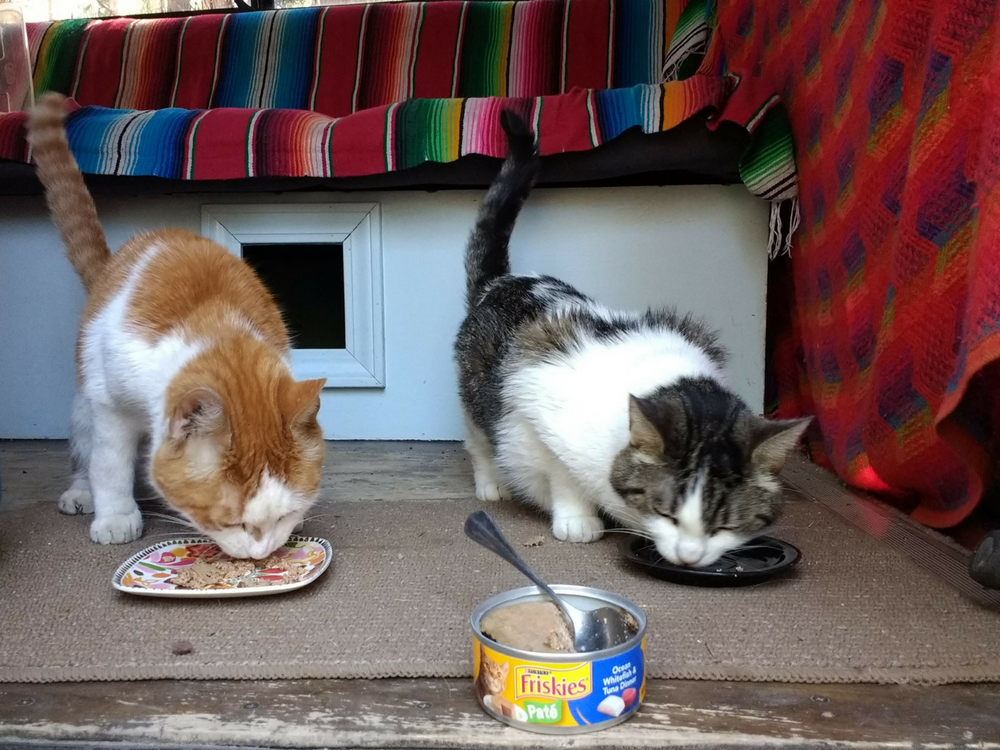
14 Tips Every Cat Owner Should Know
RVing with cats may not seem like the most natural thing to do. For many people, just bringing their cats in the car to the vet is a stressful undertaking.
When we first moved into our 37-foot Class A RV full-time, we had four cats that were coming along with us and we had no idea how it was going to work.
We’ve since been on the road for four years and had four cats in our big Class A, now down to two cats in our 21-foot Class C, and we’ve learned some things along the way.
Read below for our top tips on RVing with cats that will make your life and your cat’s more enjoyable.
Kitty litter management
We’ve found that the shower is by far the best place to keep the kitty litter. Having it in the bathroom means that you keep all those kinds of smells in the same place and the shower area will help keep the mess contained and easier to clean if anything gets kicked out of the litter box.
There are a couple of things that we recommend to keep this process as easy as possible.
1. Find a good-clumping and non-dusty kitty litter
We’ve tried many different kitty litters on our quest to find the one with the least amount of smell itself as well as hiding the smell of what goes in there. Unfortunately, the kinds that do a great job at clumping and hiding the smell also are so dusty that every time the cat uses it, you’ll smell the kitty litter all over the RV.
Your best bet is to look for a balance between clumping power and the consistency of the kitty litter itself. We’ve found Tidy Cats Lightweight Clumping Litter or a similar style to work the best.
2. Use a shower drain cover
While the shower is a great place to have the kitty litter, you do not want any of it going down the drain. Use a good quality drain cover that will ensure that you keep that spilled kitty litter out of your pipes and tanks.
3. Keep a small broom/dishpan and dish towel in the shower
Keep these items in the shower specifically for kitty litter clean-up. When you need to shower, remove the kitty litter box and set it outside the shower. Take your small broom and sweep ALL of the kitty litter that has spilled into the shower area before showering.
When you’ve finished showering, use a dishtowel to wipe the shower floor completely dry before putting the kitty litter box back in. Install hooks outside your shower specifically to hang your small broom and dishtowel on for maximum convenience.
4. Use a small bucket with a tight lid when emptying kitty litter
Keep a small bucket with a tight lid in the shower right next to your kitty litter and find small disposable bags that fit it properly.
Most likely you’ll be emptying the litter often, so it’s convenient having it right there instead of always bringing it to the garbage, while the tight-fitting lid will help keep the smell in better than a garbage can lid would.
5. Lay down a kitty litter catching mat
These mats are essential for keeping kitty litter from making a mess outside your shower. When your cats step out of the litter box, they’ll carry kitty litter out with them on their paws. These mats do a great job collecting the litter before it gets dragged around your RV.
Getting kitty some fresh air
Some cats are perfectly fine hanging out in the RV all day every day, while others will want to get out the minute you’re parked. We’re sure you already know which type you have. Here are some tips for traveling with those cats who like the sunshine and fresh air.
6. Take them out with a harness collar and leash
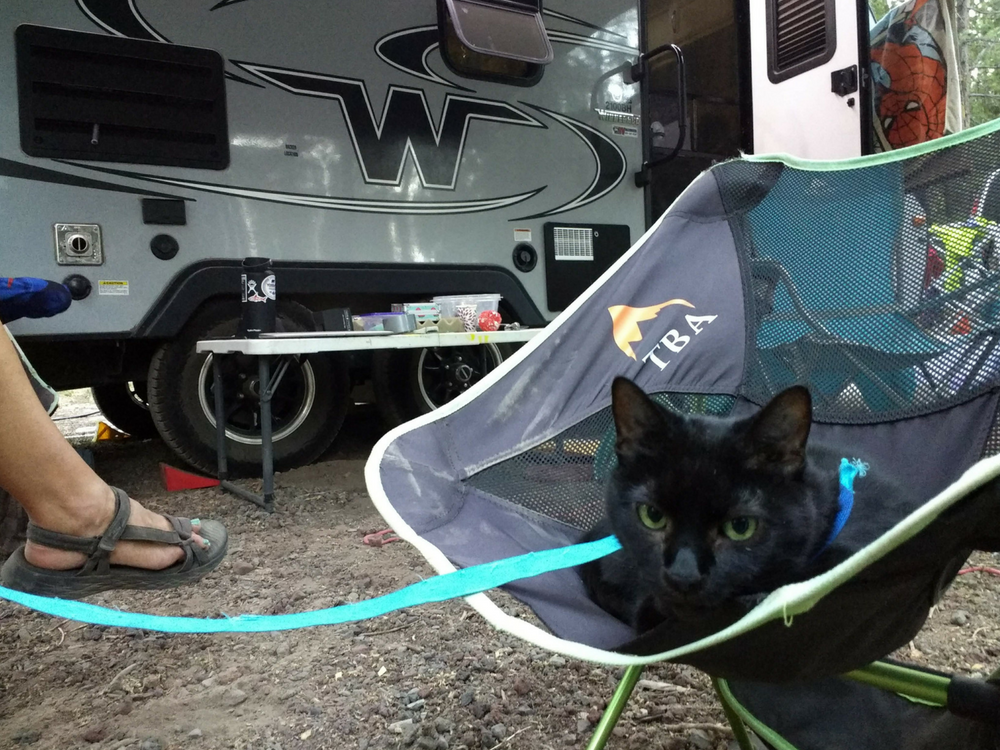
If you plan on taking your cats outside at all on a leash, these harness-style collars are the safest bet for your cat. If your cat gets away from you with its leash and collar still on, they could get the leash caught on something and end up hanging by the collar. If the collar is a basic neck collar, this could be very harmful to them.
The harness collars are designed so that even if they get caught up, they won’t get hurt hanging there waiting for you to find them. Also, we’ve found that it makes it easier to gently pull them out from under the RV if they happen to crawl under and find that one spot (like they always do!) where you can’t quite reach them.
7. Set up an outdoor enclosure
When choosing an outdoor enclosure for our cats, we knew we wanted something that was easy to set up and take down. This style enclosure is lightweight and easy to set up and pack.
It also has a bottom which helps ensure your cats will not sneak under the sides, as well as prevents them from eating grass and puking it up all over your RV later.
8. Set up a special spot in the RV for your cat
If you have a cat that enjoys staying in the RV, think about setting up a quiet spot where they can get some space and privacy.
This might not be the easiest in a small space, but removing a bottom drawer or a cupboard door and putting a kitty bed in the space inside could be enough to do the trick.
Keeping track of your feline escape artist
If you have a cat that is either used to being outside at home or tries to escape out the door every time someone opens it, you’ll be in for a challenge while RVing with them.
The last thing you want to do is be all packed up to go and realize that your cat is nowhere to be found. Luckily, there are some special precautions you can take.
9. Use a special treat to train them to come back
This is one that you might not have thought about, but it’s been a lifesaver for us many times. If your cat runs out every time the door opens you’ll want a way to get them to come back, or even just out from that one spot under the RV where you can’t reach them.
Keep a special treat that you pull out and use only for this purpose. Shake a dry treat bag or clang a dish that you always use for wet treats and they’ll probably figure it out soon enough.
10. Set up a way to track them
This is another great idea if you’re RVing with a little feline escape artist. You can purchase a tracking collar or you can purchase a more simple device that is meant to track your keys and just hook it to your pet’s collar.
11. Get them microchipped
If your cat has a breakaway collar, which we do recommend for safety reasons, then having a tracking device or even a tag with your information on it may not do the trick.
Although it’s not for everyone, getting a microchip inserted in your cat is another way to improve your chances or finding a lost cat.
Additional must-haves for RVing with cats
12. Use a folding cloth carrier
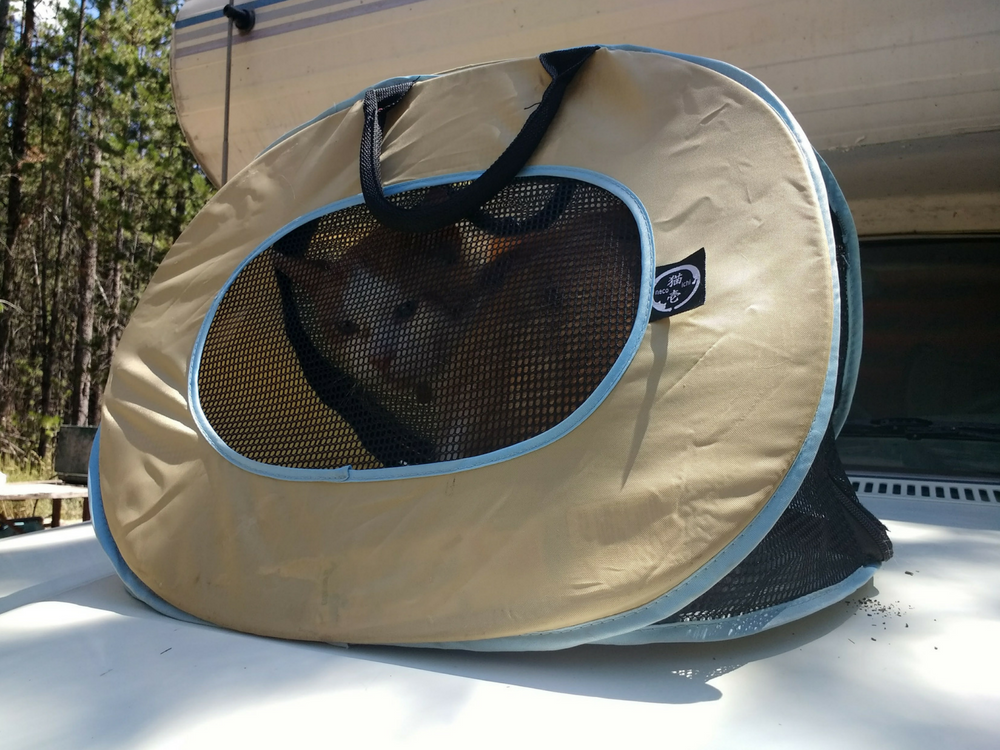
These things are super handy and lightweight. They fold up flat when you’re not using them, making them easy to store anywhere. We have a very basic carrier and it’s sturdy enough to hold our large cat without folding in on her.
13. Use a raised food and water dish holder
Depending on the size of your rig, it might not be as easy to find a nice spot tucked away from foot traffic to keep your cat’s food and water dishes. These inexpensive dish holders are a great way to prevent your cat’s food and water from constantly being kicked over in your RV.
14. Set up a scratching post
If you have room in your RV, you may be able to fit a standard cat tree or post in it. That’s great!
If, however, you are traveling in a smaller rig, think about ways you can incorporate scratching material throughout your rig. We wound some rope around the leg of our table to create a DIY scratching post for our cats.
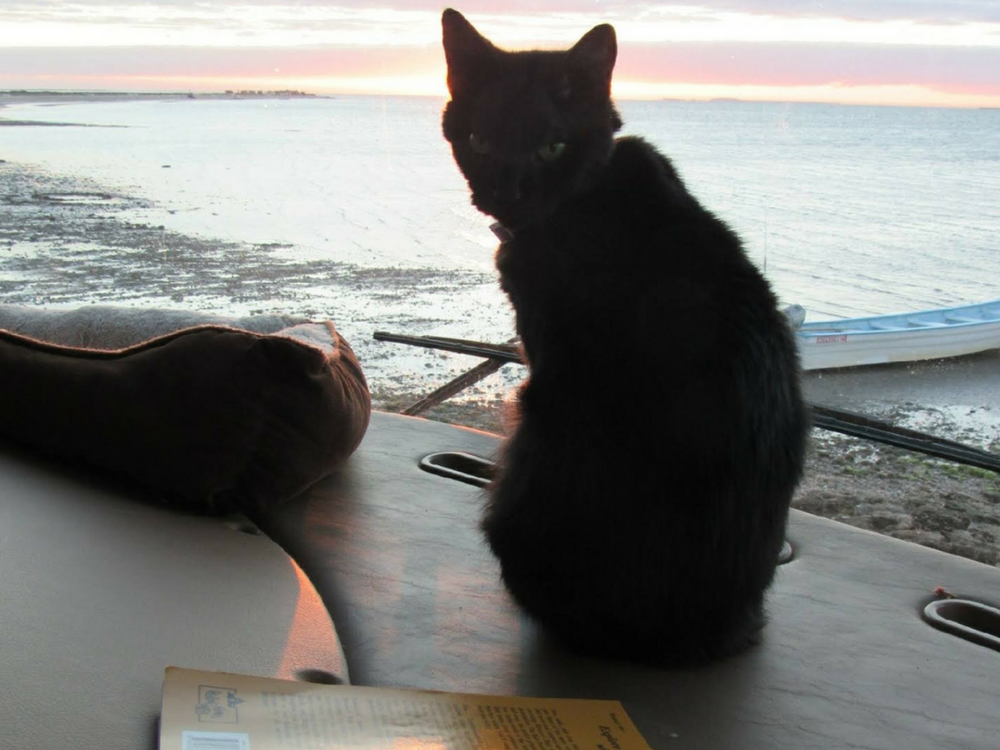
RVing with cats can be a rewarding and fun experience for both you and your cats. So whether you are thinking of taking your furry friend on your next road trip or contemplating whether it’s an option to RV full-time, just follow these tips and you’ll find that RVing with cats is not only possible but can be an extremely enjoyable adventure.


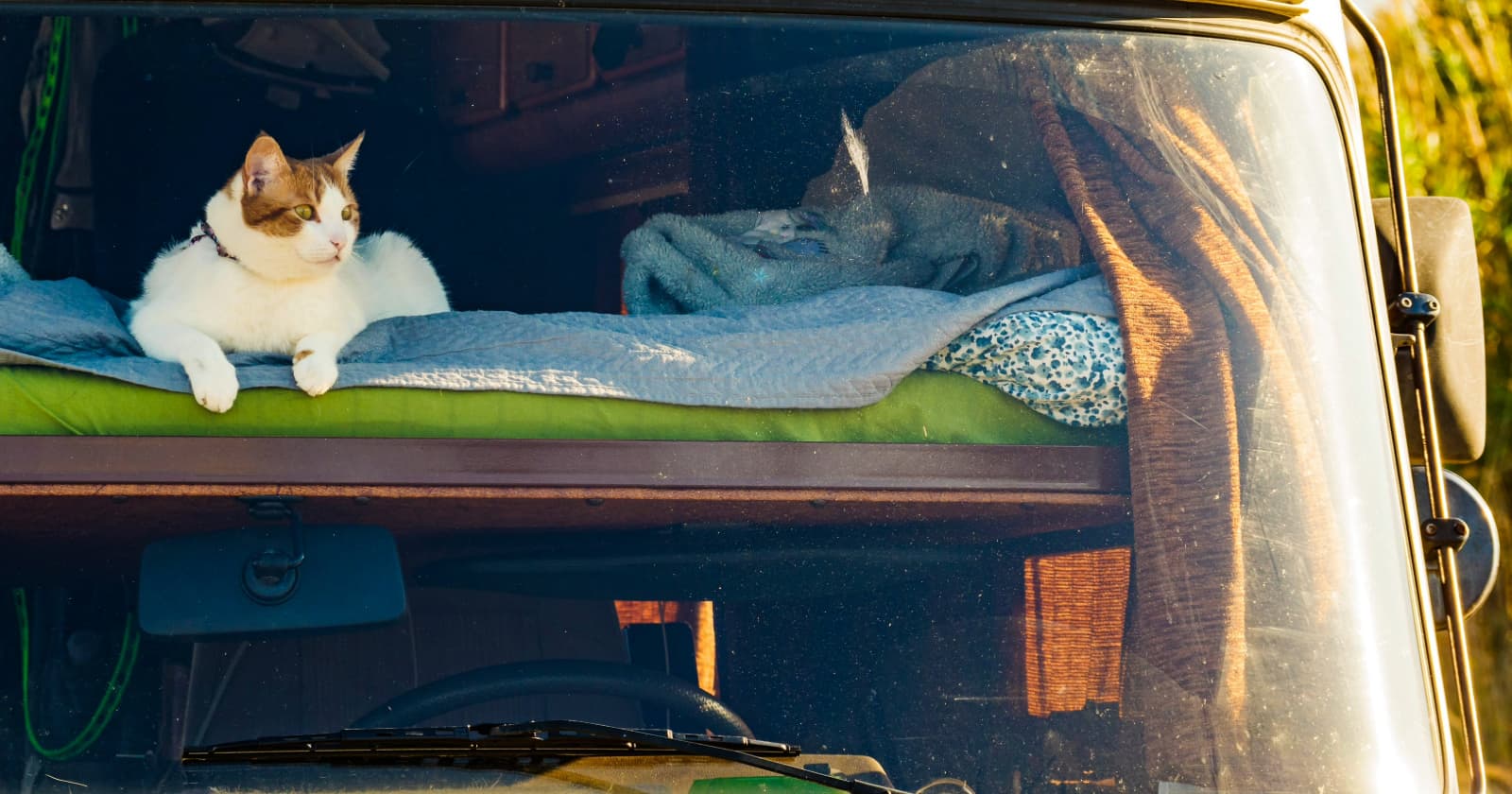
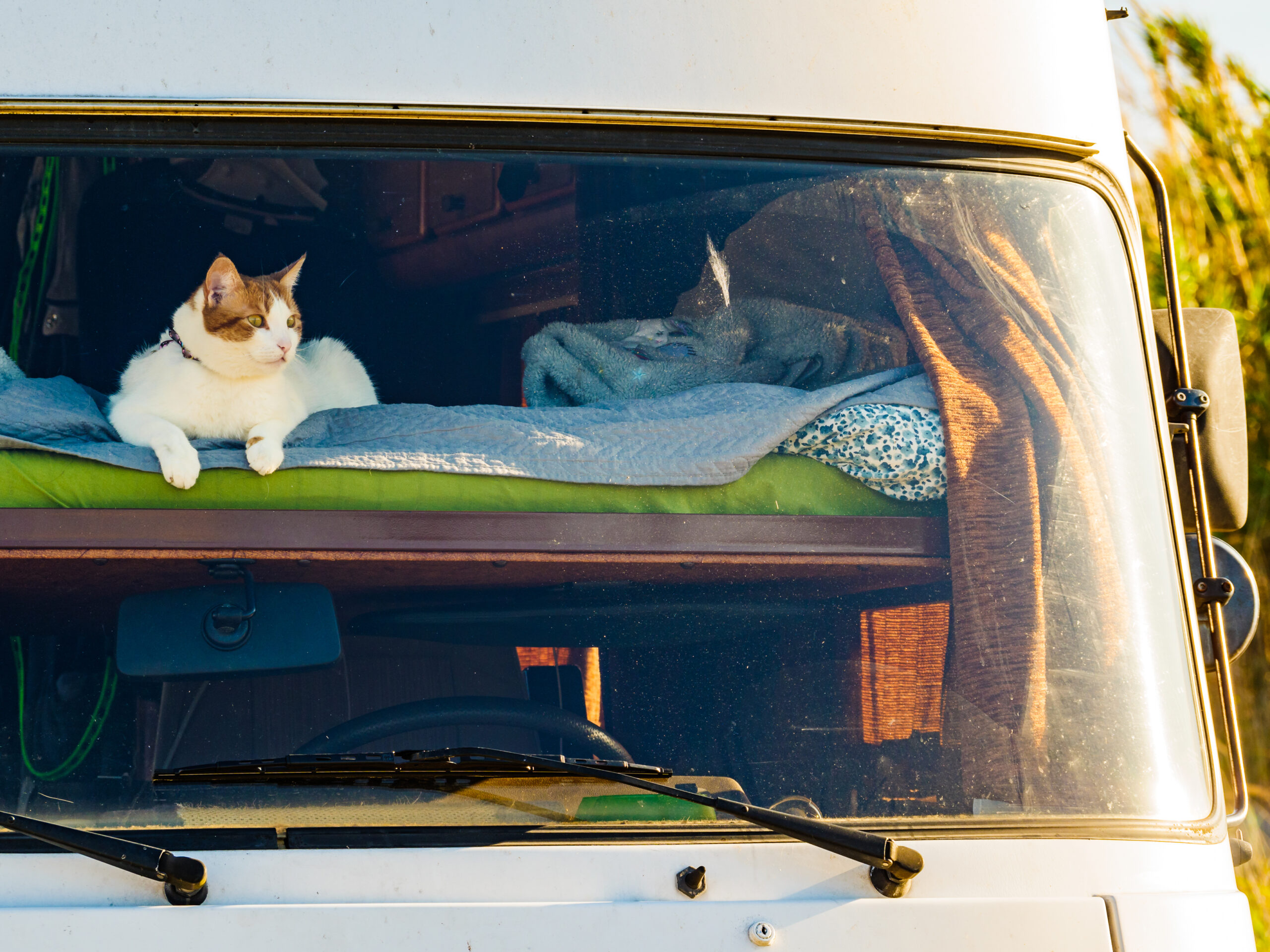
I have not found a collar/harness that my younger cat cannot escape from. It takes me longer to put the harness on than it does for her to get out of it. So I started training her. I have a leash hanging on the front door of my house. When I get the leash she knows she gets to go for a walk. She sits there quietly while I put the leash on. Then we go outside for about 5 minutes. My older cat has been watching and is almost ready to start training. They should be ready just about time the shuttle/RV is ready to go.
We have done traveling in my car. My younger cat is teaching the older cat how to open the windows. She has discovered that if we stop at a rest stop and I let them out of their carriers, she heads for the driver’s window immediately to see if she can open the window. Now I take the keys out before I let them out of the carriers.
Friskies is not a healthy cat food. Hard on the kidneys.
My cats are picky about kitty litter. I use Arm ‘N Hammer.
What consideration do RVers with feline companions have to give to the fact a lot of wild critters from coyotes to owls and hawks, and other species, would love to have a cat for lunch? Even in some developed city neighborhoods, critters are into grabbing an occasional cat. I live in the middle of densely housed urban Tucson and have seen a few coyotes running the alleys or redtail hawks circling over the middle schools mature trees. My sister in law lived in a suburb and couldn’t keep a cat too many months thanks to large owls.
My cat was accidentally caught when the storm door closed in our former home. Since then, she’s been very cautious about screen doors. Though she loves to be outside, if I say, No!, she backs away from the door. She was five when we started rving and eventually learned that she couldn’t go out without her gear on. She can escape from the halter if hung up on something, so I never leave her alone. She has a mesh tent and that’s nicer for me than her! We walk daily at least twice, or wander. Biggest danger is other camper’s dogs. If we are parked at my daughter’s farm, Mitzi can wander without restraint. To get her to come in, I just ask if she wants to eat or a treat. She understands human!
We moved from Texas to NC many years ago, with 2 cats in tow. I was driving a Astrovan, we had a large dog carrier, with a plastic shoe box for the time in the van. Out of the van we stayed at campgrounds-and continued for 8 weeks while looking for a home. So camping with cats is something we did a lot. Careful leash training was important, and then the cats got used to staying in the kids tents during the day. We moved once and lost the cats, they ran off as we where packing. Cant remember how that happened, but the kids chased and chased. I went back alone and they both came right up to me. Ill remember the treat idea if I have cats when I get my trailer.